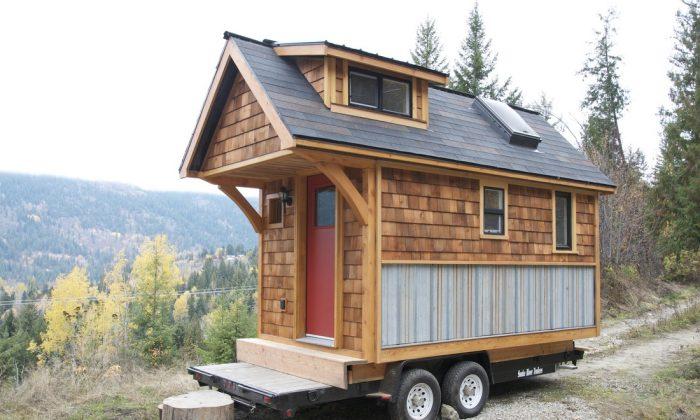As Canada’s overpriced housing market continues to skyrocket out of reach for many families, increasing to an average house price of nearly $410,000 last week, more and more Canadians are looking for affordable housing solutions outside the box.
The tiny home movement, or “extreme downsizing,” is one such growing trend: small, compact homes typically less than 500 square feet that are designed for efficiency, sustainability, and maximal use of space.
Intern architect Andy Thomson has been designing and living in tiny homes for the past decade. He has seen interest in small-scale, simple living take off in recent years, and is currently designing a 50-acre community of 20 tiny homes on the banks of the Ottawa River to help meet the growing demand.
“People are just sick of big spaces, cleaning them, paying for them, and everything else,” says Thomson. “There’s a demand there for living smarter, lighter, with less space and more efficient design.”
“So that’s when you go, ‘Couldn’t I do better than what the market is offering me?’ For sure—tiny homes fit the bill.”
Thomson’s mini-homes, usually 300-500 square feet, are designed to be mobile, completely off-grid, and self-sustained. This helps bypass some of the issues that arise from restrictive city bylaws, zoning problems, land costs, reliance on municipal infrastructure, and potential concerns from neighbours.
According to the Canadian Home Builders Association, average home sizes in Canada peaked in the mid-2000s at 2,300 square feet. Although “extreme” tiny homes of a few hundred square feet are still rare, there has been a consistent move toward smaller homes as financial realities continue to price consumers out of the housing market.
Most cities in Canada have an abundance of red tape and zoning restrictions in place that restrict the potential growth of (non-mobile) tiny homes, says Thomson, but this is starting to change.
The shift toward smaller homes is finding the most support in British Columbia, especially Vancouver, Surrey, and Maple Ridge, where property owners have been allowed to build laneway or coach homes for years. Several other B.C. municipalities are also now in the process of changing their bylaws to follow suit.
In the U.S., the town of Spur in Texas recently declared itself “the world’s first tiny house-friendly town” and relaxed housing bylaws in a bid to attract more mobile, independent young professionals to the area.
‘Really Freeing’
Lydia Holden, a 24-year-old from Saskatoon, completed construction on a 136-square-foot house in 2012 with help from friends. She had been planning the space since she was 16, and calls it an amazing way to live.
“It’s really freeing and it’s an excellent low-income housing solution. It uses almost no power and no water—about 20 litres of water per day, including my shower,'' she says.
The tiny home movement appears to offer benefits to a broad demographic: 20-somethings like Holden can actually afford to buy their first homes, young professionals can escape the burden of a huge mortgage and work less, and retirees or empty nesters can downsize in order to afford lifestyle perks like travel.
If pop culture is any indication, the idea seems to be catching on. Online magazines about tiny-house living have been popping up in recent years and the first reality show about tiny homes—Tiny House Nation—began airing on FYI last year. It was recently renewed for a second season after boosting the channel’s viewership ratings in its timeslot by nearly 50 percent among adults aged 25-54.
Thomson says that although most of his clients are educated professionals and retirees, living small can work for anyone with the will to do it, even young families with children. In his first years experimenting with small homes as a UBC student, he would tow his house to a park and let his young children play outside while he and his wife cooked dinner.
“That was amazing as a student living experience because I wasn’t paying rent, there’s lots of free parking in Vancouver, and we had a very comfortable home,” he says. “The simplicity of living like that and not having to deal with the rent and utilities and first and last month’s rent is liberating, for sure.”
Thomson says the experience of living small has also helped him “radically” reduce his consumption, spend more time outside, and reduce his carbon footprint from thirty tonnes to less than one.
With files from The Canadian Press





Friends Read Free